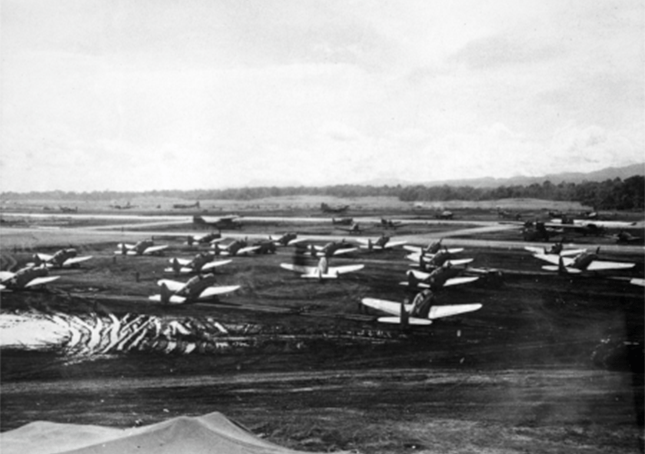Cactus Air Force

Cactus Air Force refers to the ensemble of Allied air power assigned to the island of Guadalcanal from August 1942 until December 1942 during the early stages of the Guadalcanal Campaign, particularly those operating from Henderson Field. The term “Cactus” comes from the Allied code name for the island. In 1943 the Cactus Air Force was subsumed into AirSols, a joint command of Allied air units in the Solomon Islands.
On 7 December 1941, the Japanese attacked the U.S. Pacific fleet at Pearl Harbor, Hawaii. The attack crippled much of the U.S. battleship fleet and led to a state of war between the two nations. In launching this war, Japanese leaders sought to neutralize the American fleet, seize possessions rich in natural resources, and obtain strategic military bases to defend their far-flung empire. Japanese forces also attacked and took control of Hong Kong, the Philippines, Thailand, Malaya, Singapore, the Dutch East Indies, Wake Island, New Britain, and Guam.[1]
Two attempts by the Japanese to extend their defensive perimeter in the south and central Pacific were thwarted in the Battle of the Coral Sea (May 1942) and the Battle of Midway (June 1942). These two strategic victories for the Allies provided an opportunity to take the initiative and launch a counter-offensive against the Japanese somewhere in the Pacific. The Allies chose the Solomon Islands, specifically the southern Solomon Islands of Guadalcanal, Tulagi, and Florida.
Allied strategists knew that the Japanese Navy had occupied Tulagi in May 1942 and had constructed a seaplane base near there. Concern grew when in early July 1942 the Japanese Navy began constructing a significant airfield near Lunga Point on nearby Guadalcanal island. These bases, when complete, would protect Japan’s major base at Rabaul, threaten Allied supply and communication lines across the South Pacific to Australia and New Zealand, and establish a staging base for possible future offensives against the New Hebrides, Fiji, Samoa, and New Caledonia.
The Allied plan to attack the southern Solomons was conceived by U.S. Navy Admiral Ernest King, the Commander in Chief of the United States Fleet. King proposed the counter-offensive to deny the use of the southern Solomon Islands by the Japanese as bases to threaten the supply routes between the United States and Australia, and to use them as starting points for a campaign with the goal of isolating the new and major Japanese base at Rabaul while also supporting the Allied New Guinea campaign. All of this had the eventual goal of opening the way for the U.S. to retake the Philippines.
The American Admiral Chester Nimitz, the Allied Commander-in-Chief for all forces in the Pacific, created the South Pacific theater of operations, with Vice Admiral Robert L. Ghormley placed in command on 19 June 1942, to direct the Allied offensive in the Solomons.
On 7 August 1942, the First Marine Division landed on Tulagi and Guadalcanal at Lunga Point, capturing the partially completed Japanese airfield and marking the first counter-offensive taken by the Allies in the Pacific Theater. More construction work began on the airfield immediately, mainly using captured Japanese equipment. On 12 August, the airfield was renamed Henderson Field, for Major Lofton R. Henderson, who was killed during the Battle of Midway and who was the first Marine Corps pilot killed during the battle. By 18 August, Henderson Field was ready for operation.
